
Contents










Focus · Written by Seong Hyekyung Photographed by Studio Kenn
Korea’s Traditional
Healing Hub
Sancheong Donguibogam Village
The Jirisan Mountain range starts at Cheonwangbong Peak and stretches north until it reaches
Sancheong-gun County, Gyeongsangnam-do Province. The county is a mountainous region but is also
an agricultural region thanks to the fertile soil around the Namgang River. Yet another industry is there:
traditional medicinal herbs. As a natural habitat for over 1,000 types of such herbs, Sancheong-gun is
emerging as the national hub of the sector.
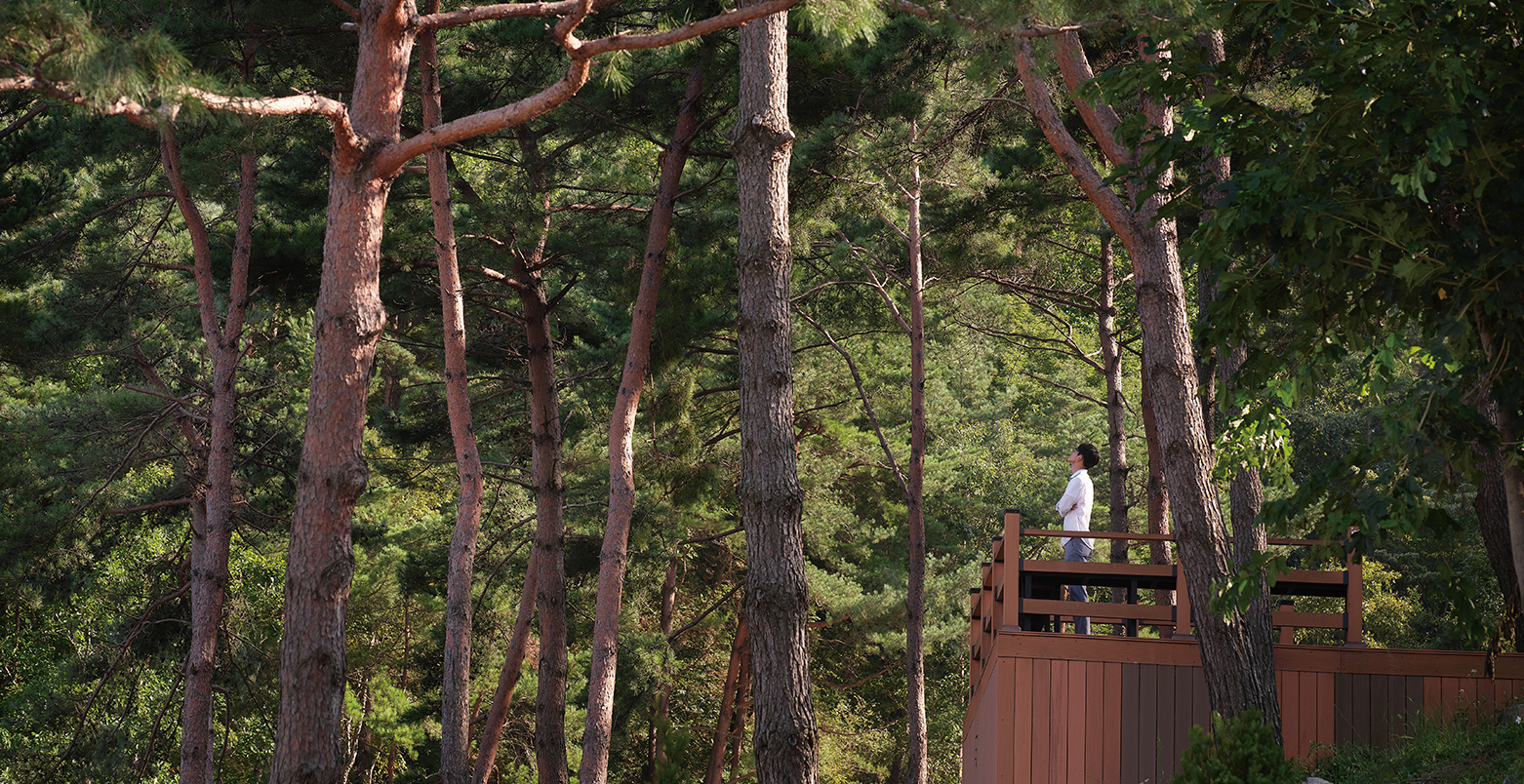
In 1610, Heo Jun, a physician for the royal family during the Joseon Dynasty (1392-1910), compiled medical information from textbooks from China and Joseon (Korea) and published Donguibogam: Principles and Practice of Eastern Medicine. Listed on UNESCO’s Memory of the World Register, the book is referred to as “the best encyclopedia for Eastern medical knowledge.” Sancheong-gun County is where Heo learned and practiced his medical techniques, along with other famous doctors including Yoo Ui-tae, Heo’s teacher, and brothers Cho Sam and Cho Gaek. Records of the county’s medicinal herbs being given as offerings to the king can be found in Veritable Records of King Sejong, Augmented Survey of Korean Geography and Imwon Sibyukji.
In addition to Korean medicinal herbs, Sancheong-gun is striving to develop a culture of healing and a tourism industry based on its outstanding traditional culture, natural landscape and convenient transportation system.
The Way of the Donguibogam Pilgrim, as part of this effort, is a unique trail in which history, nature and traditional Korean medicine converge. The 21km-long path covers Donguibogam Village; Wangsan, where King Suro spent his latter years; and Pilbongsan Mountain, where the royal tomb of King Guhyeon, the last monarch of Geungwangaya, is located. Further up from the tomb is a mineral spring, where Yoo is said to have made an extract from medicinal herbs using the spring water while practicing medicine on the mountain.
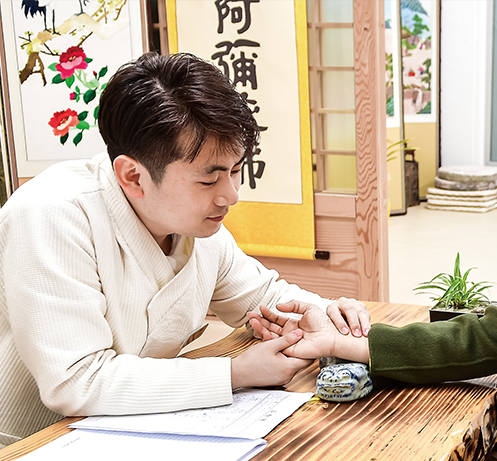 A traditional Korean medicine doctor can be seen checking the patient’s pulse. © Donguibogam Oriental Medicine Clinic
A traditional Korean medicine doctor can be seen checking the patient’s pulse. © Donguibogam Oriental Medicine Clinic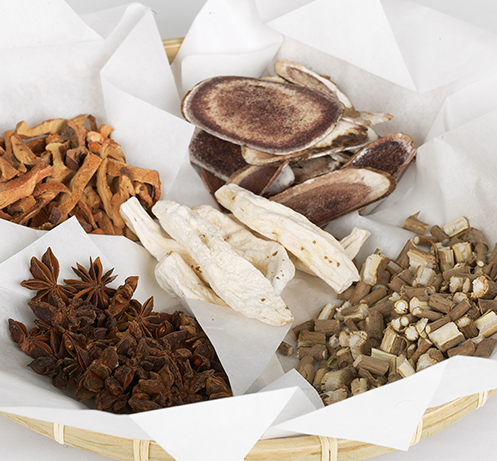 You can decoct medicinal herbs in person, or turn the herbs into accessories to carry around. © imagetoday
You can decoct medicinal herbs in person, or turn the herbs into accessories to carry around. © imagetoday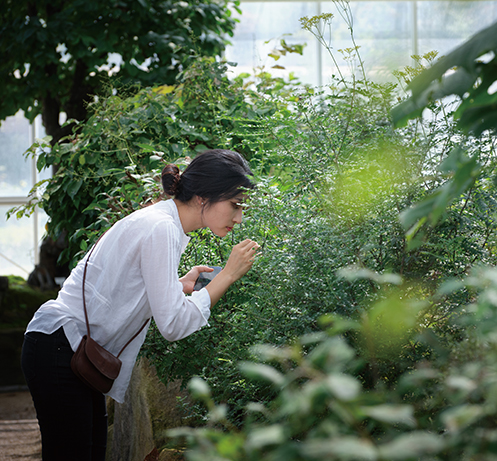 Visiting Medicinal Herb Hall filled with aromatic herbs naturally refreshes your mind.
Visiting Medicinal Herb Hall filled with aromatic herbs naturally refreshes your mind.Five Walking Courses
The Way of the Donguibogam Pilgrim is connected to five walking courses on the Jirisan Trail that are considered to be the most beautiful on Jirisan Mountain; the five courses are located between the villages of Sanjeong Banggok and Sucheol.
The courses start at Memorial Park for the Sancheong-Hamyang Massacre, which honors 705 residents from the counties of Hamyang and Sancheong killed in a mission during the Korean War to subdue the Jirisan red guerrillas.
Past the park, twisting and unpaved forest paths emerge with a ravine on their side along with the beautiful sight of green pine trees and gold and silver grass. After walking for roughly 30 minutes, a massive rock cliff and the 20-meter-tall Sangsa Falls flowing over the cliff’s surface appear. From that point, the path goes up and down the hill, and the trail proceeding through the forest finally reaches its highest point, Godongjae Pass (550m above sea level), with a fantastic and expansive view. The area around the pass is the only place on the mountain where wild ginseng can be dug up from the ground.
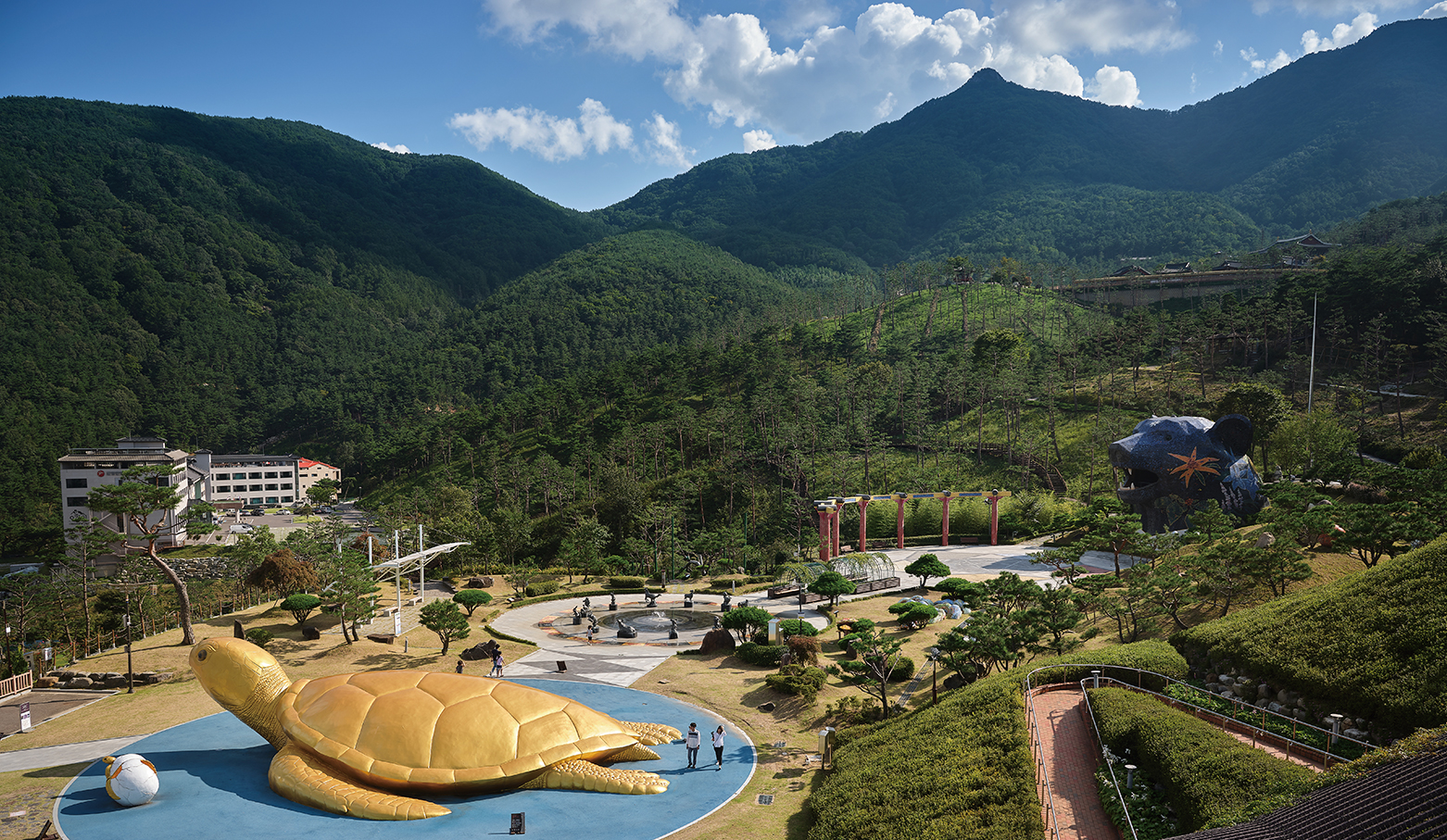
The park is featured with various sculptures and structures such as a gold turtle symbolizing longevity as well as a bear and tiger in Dangun mythology.
Emerging Tourism Destination
On the Way of the Donguibogam Pilgrim is Sancheong Donguibogam Village, where Jirisan’s northern range ends after starting from Cheongwangbong Peak. This is where the energy of the great mountain reaches and the famous village stands. The main stage of the 2013 Sancheong World Traditional Medicine Expo, Sancheong-gun has developed the village as a tourism destination utilizing its historic significance and natural environment.
The village is also the nation’s first medicine-themed tourist attraction and includes a traditional medicine park, a medicinal herb museum, a Korean energy (gi) experiential zone, Oriental Medicine Natural Recreation Forest and an Oriental medical clinic.
The Korean Medicine Museum shows the footsteps of herbal medicine that has protected the health of Koreans for thousands of years. The first floor houses an exhibition marking the 400th anniversary of Donguibogam’s publication and its registration as a UNESCO Memory of World. The Traditional Medicine Room displays the history, traditional remedies and excellence of Korean medicine with miniature figures that show the process of making traditional medicine to foreign visitors. The second exhibition room has a collection of medicinal herbs organized in sections to show the herbs’ history and categories and information on Sancheong-gun.
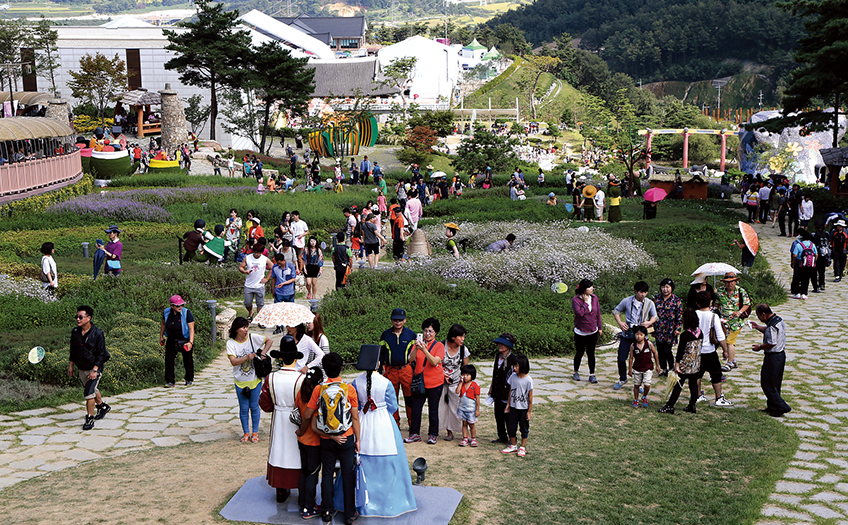
Visitors can be seen taking photos in Medicinal Herb Theme Park. © Sancheong-gun County
Sancheong Medicinal Herb Museum houses a range of indigenous medicinal herbs that grow in the county. The museum interior is decorated in the form of Jirisan Mountain, Cheonwangbong Peak and Hwangmaesan Mountain and cultivates natural medicinal herbs and rare medicinal plants. One hundred species of wild medicinal herbs grown on the mountain are displayed here as well as rare trees such as boxthorns, Korean wild grapes and Siberian gooseberries over 100 years old.
The most popular space in the village is the experiential zone of traditional Korean medicine. Known for having the best energy in Korea, the zone has three rocks -- Seokgyeong, Guigamseok and Bokseokjeong -- to experience gi (energy). To experience Seokgyeong’s energy, a visitor just places his or her forehead on the rock. Guigamseok, which resembles a turtle, is said to have the energy of the Earth, so hugging or placing one’s back on the stone is said to produce positive energy. This rock attracts large crowds. In front of Guigamseok, visitors can also follow the movements of a gi exercise specialist. This 130-ton rock was brought from Hwangmaesan Mountain. Bokjeongseok, which means “a stone bringing good fortune,” is said to grant wishes to anyone walking around it.
Visitors to the village can also enjoy other unique experiences through medicinal herb programs such as a medicinal herb spa, a foot bath, dressing up in traditional doctor and nurse costumes, a heat experience, classes for making soap from medicinal herbs, a giant moxa cautery on the belly button, Gongjin-dan making classes and packing herbal medicine.
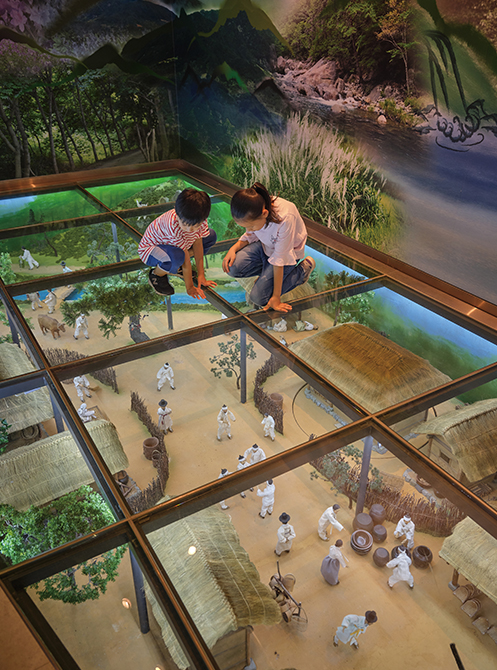 In a museum, two children can be seen looking down at miniatures, displaying what it was like to live in the Joseon dynasty.
In a museum, two children can be seen looking down at miniatures, displaying what it was like to live in the Joseon dynasty.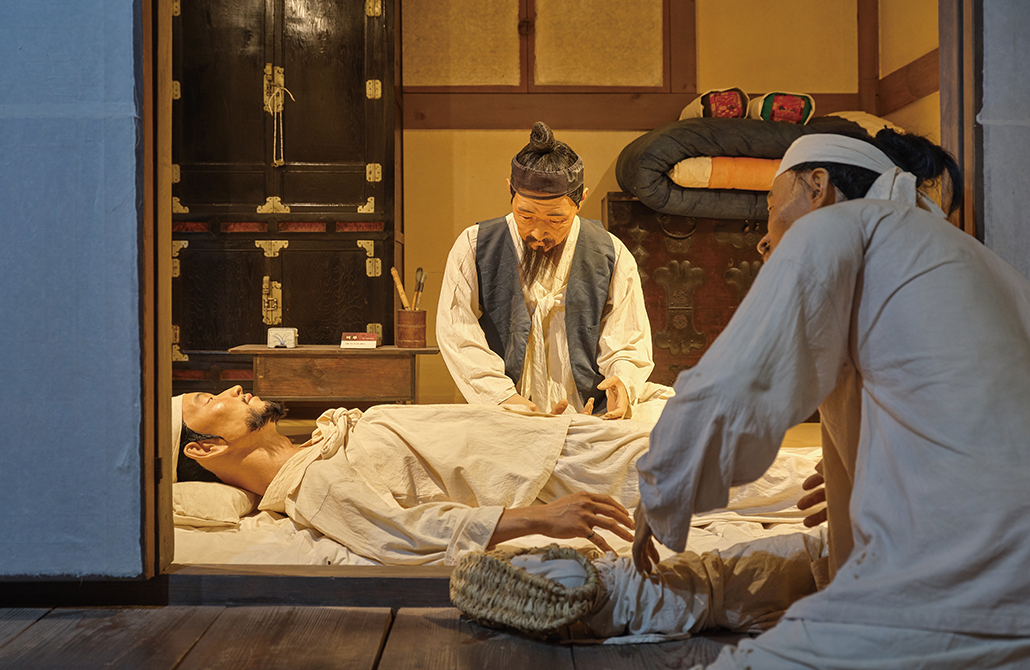 This scene re-enacts how the doctor was treating patients in a traditional doctor’s office during the Joseon period.
This scene re-enacts how the doctor was treating patients in a traditional doctor’s office during the Joseon period.Other Articles















